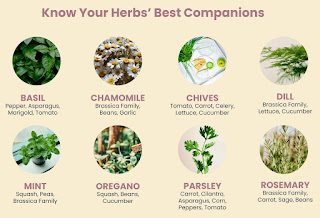2025-01-27 - Companion Planting Herbs With Vegetables
Companion Planting Herbs With Vegetables
Companion planting is a technique for designing a balanced and abundant garden where plants support each other. This principle is widely used in permaculture as it helps improve biodiversity and limits the use of chemical fertilizers and insecticides.
Here are a few reasons why it’s beneficial to pair companion plants in a vegetable garden:
Pollination
Attracting pollinators to the garden boosts fruit and vegetable growth.
Layout
Combining tall and low varieties maximizes your growing space.
Improved Soil Quality
Certain plants improve the soil:
· Legumes, for example, enrich the soil with nitrogen, which is crucial for growing vegetation.
· Deep-root plants help loosen compacted soil while drawing their nutrients deep in the ground.
Soil Moisture Maintenance and Weed Management
Some plants with dense and low foliage (like squash and potatoes) create a natural plant mulch that will maintain soil moisture, limiting weed growth and the need to water.
Pest Control
A lot of vegetation, especially fragrant plants like flowers and herbs, acts as natural repellents by deterring insect pests and small animals from coming into the garden.
Limit Disease Spread
Adding companion plants between plants from the same family can limit the spread of diseases by creating a kind of barrier.
Shade and Wind Protection
Tall and wide plants (like tomatoes) provide shade for smaller, more fragile plants (like lettuce and basil) or protect them from the wind.
Similar Needs
It may be beneficial to group plants that need sunlight into the sunniest part of the garden or put water-hungry plants together to make watering easier.
Natural Stakes
Plants with tall and sturdy stems (like corn and sunflowers) could be stakes for climbing plants (like beans and cucumbers).
|
Herb |
Good Companion Plants |
Bad Companion Plants |
|
Basil |
Asparagus, beans, bell pepper, tomato |
|
|
Chives |
Carrot, squash, zucchini, strawberry, parsley, tomato |
Beans |
|
Cilantro |
Beet, carrot, cabbage, cucumber, potato |
|
|
Dill |
Broccoli, cabbage, Brussels sprouts, cauliflower, lettuce, turnip, onion |
Carrot |
|
Marjoram |
Zucchini, hot pepper, bell pepper |
Thyme |
|
Mint |
Broccoli, cabbage, Brussels sprouts, cauliflower, pumpkin, squash, turnip, tomato |
|
|
Oregano |
Broccoli, cabbage, cauliflower, zucchini, bell pepper |
Thyme |
|
Parsley |
Asparagus, chives, tomato |
Celery, lettuce, onion, leek |
|
Rosemary |
Broccoli, carrot, cabbage, Brussels sprouts, cauliflower, beans, turnip, sage |
|
|
Sage |
Broccoli, carrot, cabbage, Brussels sprouts, cauliflower, beans, rosemary, tomato |
Cucumber |
|
Tarragon |
Eggplant, thyme |
|
|
Thyme |
Eggplant, broccoli, cabbage, Brussels sprouts, cauliflower, tarragon, strawberry, potato, tomato |
Marjoram, oregano |



